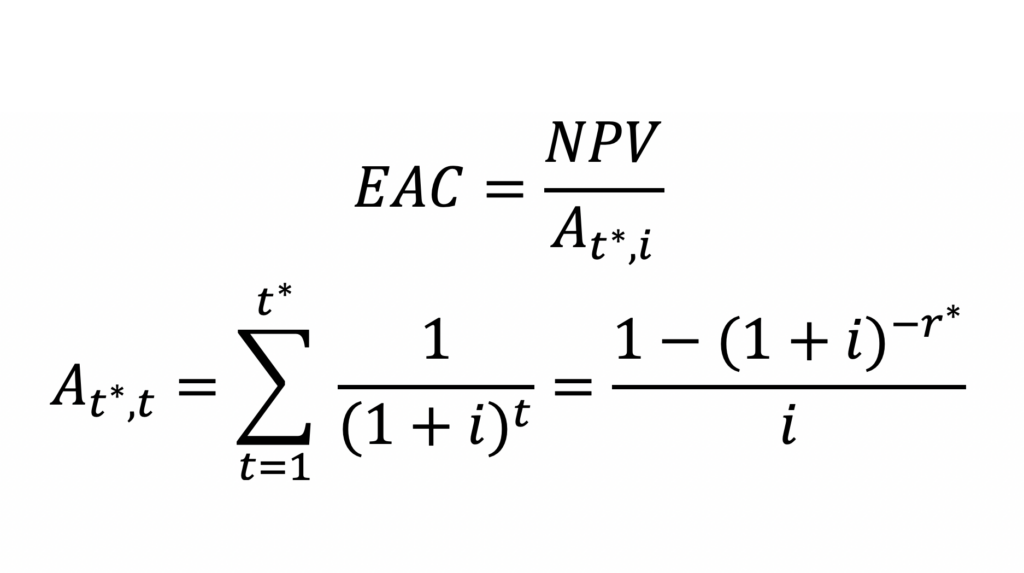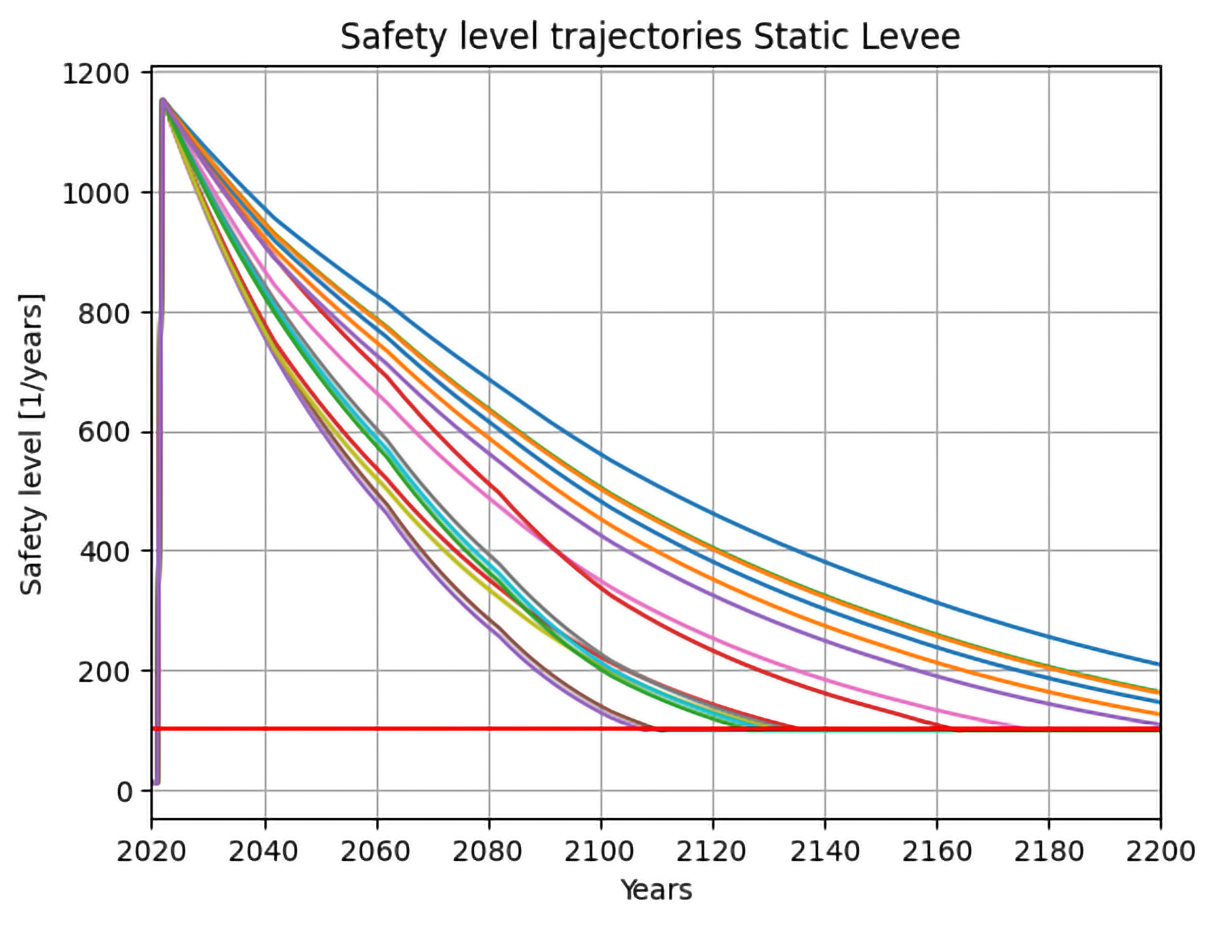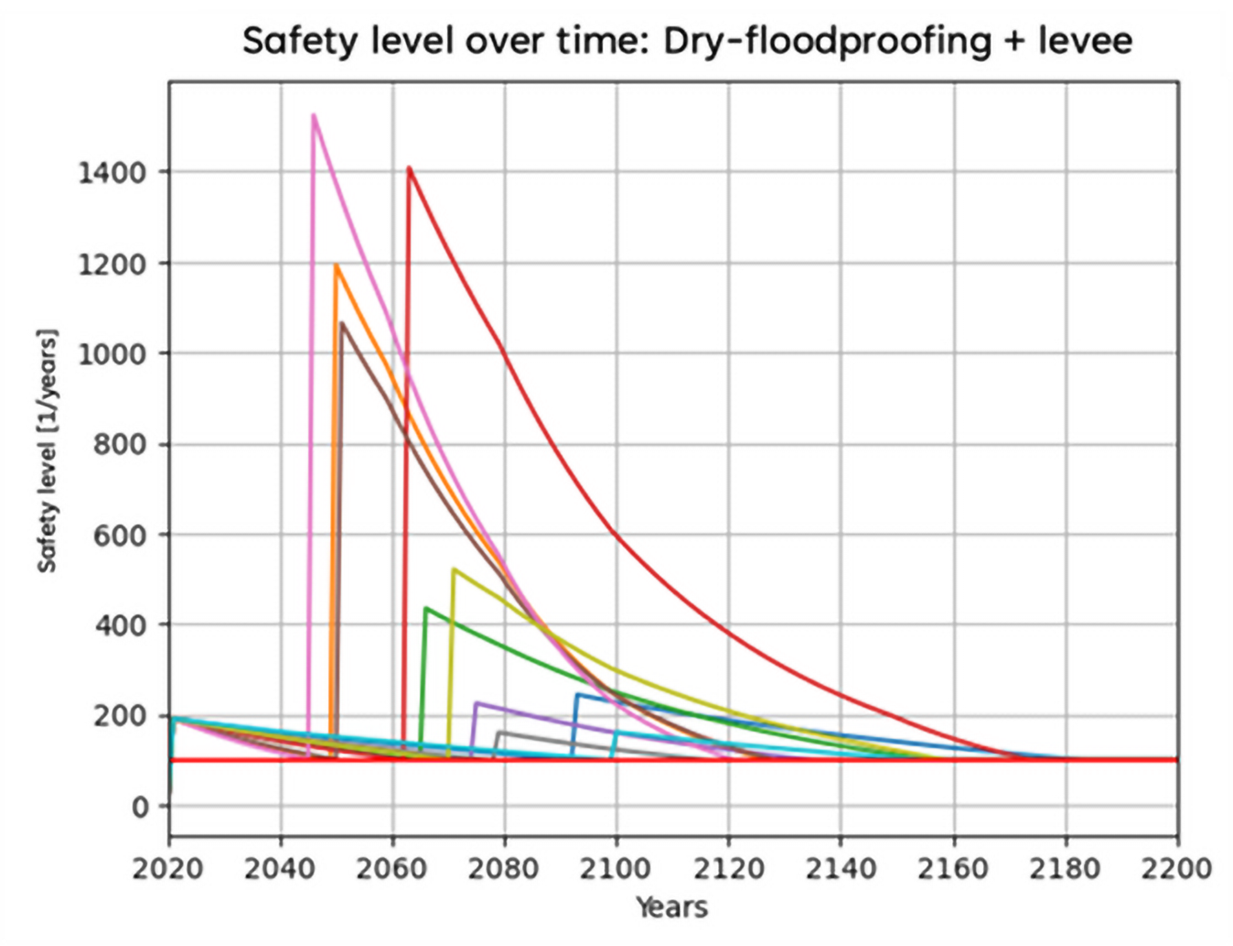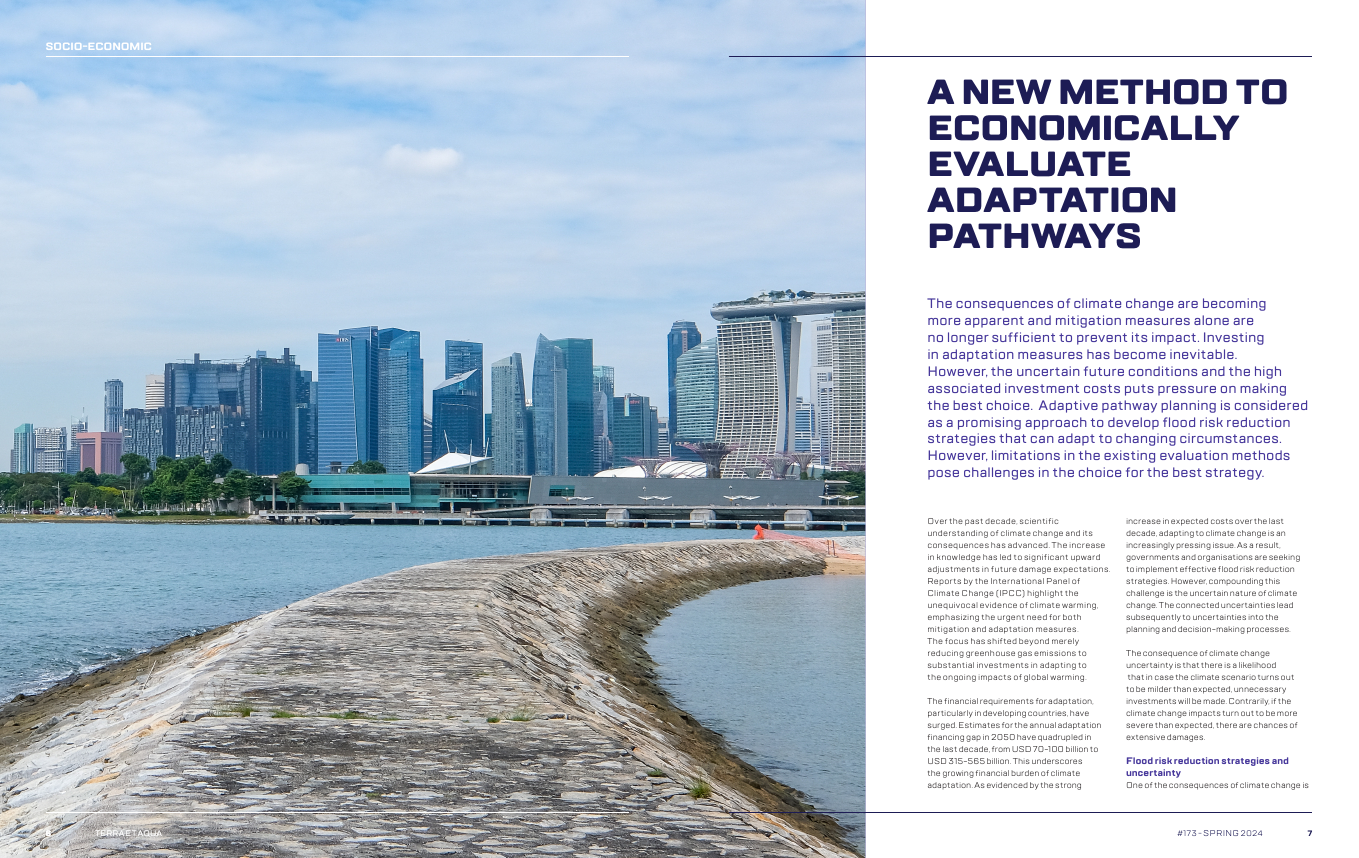Adaptation pathways
To develop effective flood risk reduction
strategies that can adapt to changing
circumstances, planning approaches that
incorporate adaptability and flexibility are
essential. To accommodate flexibility into
decision-making and account for the evolving
nature of flood risk, the application of
“adaptation pathways” has been identified
as a promising approach. Adaptive pathway
planning enables decision-making over time,
in response to how the future unfolds.
The dynamic adaptive policy pathways
(DAPP) method is a method in which adaptive
pathways are used to develop plans that are
subject to uncertainty (Haasnoot et al., 2013).
Figure 1 shows a schematic overview
of a pathway map, a feature of the DAPP
approach. It shows the available actions and
the different pathways that can be chosen.
The methodology is based on the idea that
investment choices (or actions) have a finite
lifespan and may no longer meet goals if
circumstances change, i.e., when a threshold is
crossed, known as the adaptation tipping point
(ATP) (Kwadijk et al., 2010).
In a flood risk reduction strategy, for example,
sea level rise can result in a minimum safety
level no longer being met. When an action
no longer fulfils the objective, new actions
are required to meet the standards again,
leading to a variety of alternate pathways.
The trade-offs between their costs and
benefits will determine which pathways are
preferred over others. If there is only one initial
decision moment, the strategy is considered
static. However, if there are opportunities to
make decisions based on available knowledge
at different points in the design process,
the strategy is flexible or adaptive.
While adaptive planning offers advantages,
it also presents challenges and weaknesses
compared to static approaches. Some
challenges include uncertainty in future
developments, potential trade-offs between
short-term and long-term objectives,
and the need for continuous monitoring
and adjustment. In contrast, static
approaches provide a more straightforward
and predictable framework but may lack the
ability to respond effectively to changing
circumstances. To discover which strategy is
optimal for a project location, adequate and
thorough evaluation is necessary.
Economic evaluation
Various methods exist for economically
evaluating adaptive strategies, including
cost-benefit analysis (CBA), real option
analysis (ROA) and robust decision making
(RDM). Multiple flood risk evaluation methods
have been evaluated and it was found that
each method comes with its own strengths
and limitations. The premise of adaptive
pathway planning is the ability to re-evaluate
and reassess taken or possible new actions.
Currently, no method is found to evaluate
strategies under uncertain conditions and
include the premise adaptation pathways.
Research objective
This research focussed on filling these
identified gaps and contributing to enhancing
the economic evaluation of adaptive pathways.
Without an adequate evaluation method,
validating positive expectations about
adaptive pathway planning remains
challenging. The study was divided into
three subtopics:
- Evaluation of current evaluation methods.
- Investigate the value of time
- Test new evaluation method.
Creating a new method
Analysis of evaluation methods
Multiple approaches exit to develop and
evaluate flood risk reduction strategies.
Certain methods focus on the uncertainty,
other focus more on incorporating flexibility.
For this study, the most used techniques
were evaluated to derive its strengths and
weaknesses. Based on the found results a
new method could be formulated.
Robust decision making (RDM)
RDM aims to create decision strategies that
are robust and perform well under diverse
future scenarios. It emphasises evaluating
various options, including worst-case
scenarios, to identify robust strategies.
Robust refers to the ability to perform well
even under conditions of high uncertainty or
ambiguity. Identifying strategies that are
robust helps decision-makers minimise the
risk of negative outcomes and increase the
resilience of their systems. Additionally, RDM
aims to increase transparency by taking into
account various objectives and criteria in the
decision-making process.
RDM has the ability to facilitate so called
“deliberation with analysis” (Groves et al.,
2019). This term describes the process of
decision-making where people or groups
carefully and methodically consider options
and potential outcomes before reaching a final
conclusion. It involves careful consideration of
relevant information, weighing of alternative
options and evaluation of the potential
consequences of each decision. This approach
is often used in complex situations where there
are multiple factors to be considered and
where the stakes are high.
Real option analysis (ROA)
ROA, rooted in financial option theory,
captures and values flexibility in decision-
making. It introduces the concept of real
options, allowing for changes in investments
based on new information. ROA categorises
options as “on” or “in” a system, offering
valuable insights for climate adaptation
plans. An example of a real option “on”
a system is the option to defer or abandon a
project. On the other hand, real options “in” a
system are options that are incorporated into
the design of the system. For example, making
allowance for future expansion of a levee by
over designing the foundations.
Both options “in” as options “on" a system are
valuable for climate adaptation plans. So, in
contrast with the traditional planning approach
in which only one-off investment options are
recognised, the real option’s concept is able to
take management flexibility and volatility into
account by enabling changes to an investment,
in case new information becomes available in
the future (Buurman and Babovic, 2016).
In a traditional CBA, uncertainty is included by
expected values depending on probability
distributions. The downside of this approach is
that it connects a “now or never” quality to the
decision moment. This quality is only suitable in
case there is no flexibility. However, when the
possibility exists to modify the decision, a
traditional CBA tend to undervalue. With ROA,
at every moment, the option to invest or not to
invest is evaluated. The value of options of
taking measures later or now is valued.
The ability to choose a different course of
action or to decide to postpone an action until
more information is available, results in the
opportunity to limit the negative effects of
making a poor choice while also maximising
the positive effects of the newly available
information. This aspect is the main premise of
the adaptive planning concept. However, the
downside of ROA is that it is complex to
perform as many uncertainties need to be
quantified, integrated and discretised in
scenarios, as showed by Kind et al. (2018).
Extended cost-benefit analysis (CBA)
The study of de Ruig (2020) and Haasnoot
et al. (2020) extended the traditional CBA
framework to evaluate adaptation pathways.
They both extended the time horizon of the
traditional CBA and included evaluation of
sequential measures. De Ruig’s method
(2020) incorporates both the temporal
and spatial dimensions of climate change
impacts and evaluates a range of adaptation
measures and their timing to identify the
most cost-effective and efficient pathway.
Similarly, Haasnoot et al. (2020) extended the
traditional CBA framework by incorporating
multiple scenarios and an extended time
horizon to evaluate sequences of investments
or adaptation options. The most effective
pathway is determined by the climate and
socio-economic scenario that is considered.
Transfer costs are included that quantify the
path-dependency of options.
Both methods build on the traditional CBA
framework and provide a more thorough
analysis by taking into account a range of
factors and considering the long-term effects
of climate change. The recommendation that
followed from this research is to incorporate
the flexibility in the economic assessment that
would enable alterations in the type and/or
height of subsequent measures for conditions
different from assumed.
Reduced uncertainty: the value of time
A flood risk reduction strategy is subject
to various uncertainties which makes it
difficult to design the optimal strategy.
The performance of the strategy could be
increased in case there is a possibility to
base decisions on new and more accurate
information. The “updated” knowledge which
could lead to reduced uncertainty is one of the
possible drivers of the added value of adaptive
pathway planning.


















